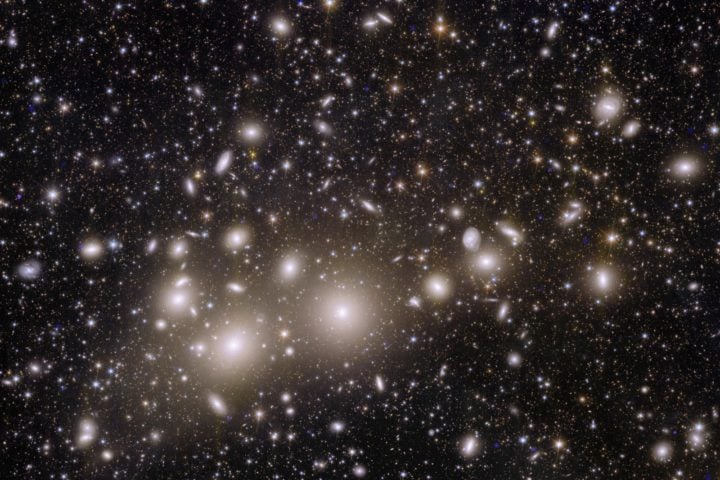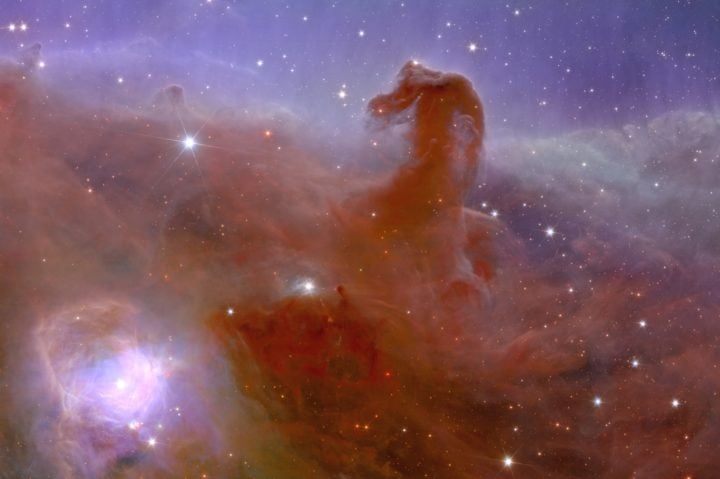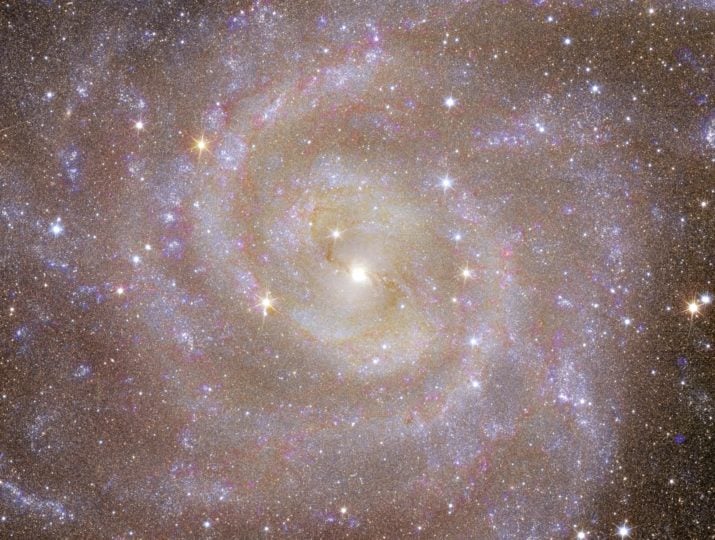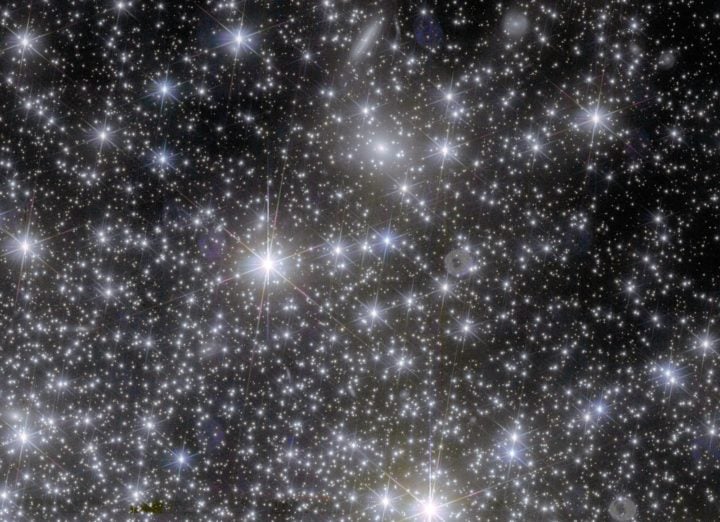The Euclid mission is the first to deliver images from nearby regions of the Universe. The spacecraft can record the data from an area of the sky more than one hundred times bigger than that imaged by the James Webb telescope’s infrared camera. With these successful images, Euclid has proven that the spacecraft, telescope and scientific instruments are ready to explore dark matter and dark energy.

The galaxies of the Perseus cluster are visible in the centre of the image and appear as large galaxies with yellow and white halos around them. The background of this image is filled with hundreds of thousands of more distant galaxies, ranging in colour from white to yellow to red (for the most distant objects). This image illustrates Euclid’s ability to capture extremely sharp images over a large area of the sky in a single acquisition. This colour image was obtained by combining data from the NISP and VIS instruments. Image credit: ESA / Euclid / Euclid Consortium / NASA, image processing by J.-C. Cuillandre, G. Anselmi ; CC BY-SA 3.0 IGO
The first images from the Euclid spacecraft provide an insight into nearby regions of the Universe. Never before has a space telescope been able to image such large sections of the sky with such resolution.
“The first images have exceeded our expectations – and this is just the beginning,” explains Alessandra Roy, Euclid project manager at the German Space Agency at the German Aerospace Center (Deutsches Zentrum für Luft- und Raumfahrt; DLR). Euclid has thus proven that the spacecraft, telescope and scientific instruments are ready for the primary mission – researching dark matter and dark energy.

Horsehead Nebula
The Horsehead Nebula in Orion is part of a large cold cloud of gas and dust visible in white-orange colours. An orange-coloured cloud in the shape of a horse’s head emerges from the nebula in the lower half of the image. This nebula envelops young stars as if in a cocoon. Many other telescopes have captured images of the Horsehead Nebula, but none of them have been able to produce such a sharp and wide an image with just one observation. Image credit: 1/5, Credit: ESA / Euclid / Euclid Consortium / NASA, image processing by J.-C. Cuillandre, G. Anselmi; CC BY-SA 3.0 IGO
Euclid observes areas of the sky over a hundred times larger than the James Webb telescope
The expectations for Euclid are high. In just six years, the European Space Agency (ESA) spacecraft is expected to scan more than a third of the sky and create a three-dimensional map of the distribution of galaxies in the Universe, which stretches across more than 10 billion light years.
This distribution resembles a gigantic cosmic web in which clusters of galaxies appear to be connected by gravity, as if by hidden threads. In order to achieve this goal, the telescope and instruments were primarily designed to capture as large a section of the sky as possible with each image.
“The resolution of Euclid is lower than that of the Hubble Space Telescope,” explains Roy. “Instead, the spacecraft specialises in observing areas of the sky that are more than a hundred times larger than those which the infrared camera of the James Webb telescope can achieve.”

IC 342 is a large spiral galaxy, similar to the Milky Way, which can be seen from the front in white and pink colours. In the image, the colours of the stars range from blue (younger stars) to white to yellow and red (older stars) across the entire image. Image credit: ESA / Euclid / Euclid Consortium / NASA, image processing by J.-C. Cuillandre, G. Anselmi; CC BY-SA 3.0 IGO
The researchers want to use the images to explore the previously unknown nature of dark matter and dark energy. These two components make up approximately 95 percent of the Universe. The Euclid data is intended to precisely determine the properties of these components in order to refine currently recognised cosmological theory and, if necessary, identify deviations within the general theory of relativity.
More than 50,000 galaxies in the image of the Perseus galaxy cluster
One of Euclid’s first five images is of the Perseus galaxy cluster. This structure is one of the most massive objects in the Universe. X-ray observations have already proven the presence of dark matter there. The Perseus cluster contains a large number of galaxies embedded in an enormous cloud of superheated gas. Euclid has imaged more than 50,000 galaxies, some of which have never been seen in images before.
The mission will primarily capture the shape of the background galaxies. Distortions within this shape will allow astronomers to measure the amount of dark matter that lies between these galaxies and the Solar System.

NGC 6822 is an irregular galaxy. Irregular galaxies have unusual shapes that could be due to a collision between galaxies. Such galaxies usually harbour a mixture of older and younger stars, depending on the properties and composition of the original galaxies. In NGC 6822, the stars contain only a small amount of heavier ‘metal elements’, which are produced by the stars during their lifetime and are therefore not very common in the early Universe. The NISP instrument will make it possible to study the star formation history of this type of galaxy. In this image, the colours of the stars range from blue (younger stars) to white to yellow and red (older stars) across the entire image. Image credit: ESA / Euclid / Euclid Consortium / NASA, image processing by J.-C. Cuillandre, G. Anselmi; CC BY-SA 3.0 IGO
The distortion of the shape of the background galaxies is a well-known effect caused by the influence of massive objects that act like lenses located between the galaxies and the observer. This phenomenon is explained by the theory of general relativity and is referred to as the weak gravitational lensing effect.
The mission will take advantage of this phenomenon and measure the distortion of the shapes of billions of galaxies as part of its overall survey. In addition, Euclid will analyse the spatial distribution of these galaxies and investigate how this has changed over the last 10 billion years. In this way, the researchers hope to find out how dark energy has influenced the expansion of the Universe.
Scientific instruments pierce the cosmic clouds in front of the Hidden Galaxy
An image of the Hidden Galaxy (IC 342) shows the power of Euclid’s Near Infrared Spectrometer and Photometer (NISP) in combination with the Visible Instrument (VIS).
The galaxy takes its name from the fact that it is located behind the disc of the Milky Way and is therefore obscured in optical light by its gas and dust. However, infrared light can pass through these cosmic clouds. The image shows many details of the individual stars and star clusters in the galaxy.

Globular clusters are stable, gravitationally bound clusters of tens of thousands to millions of stars that are found in a variety of galaxies and are among the oldest objects in the Universe. Therefore, they contain many clues about the history and evolution of their host galaxies. In the case of NGC 6397, this is the Milky Way. Euclid data should make it possible to calculate very precisely how the star clusters orbit the galaxy and thus provide information about how the dark matter is distributed in the Milky Way. Image credit: ESA / Euclid / Euclid Consortium / NASA, image processing by J.-C. Cuillandre, G. Anselmi; CC BY-SA 3.0 IGO
“Although cosmology is the main goal of this mission, Euclid data will contain valuable information about the physics of stars and galaxies, including the Milky Way,” says Alessandra Roy. There are also plans to study the Horsehead Nebula, the most famous and closest star-forming region. Here, Euclid could discover new gas giant planets similar to Jupiter, as well as stars in their early stages of formation.
The mission was launched on 1 July 2023 aboard a US SpaceX Falcon 9 rocket, which lifted off from the US spaceport at Cape Canaveral. The spacecraft reached its final position, 1.5 million kilometres from Earth, at the end of July and began collecting data. The first publication of Euclid data is planned for 2025. Until then, the researchers in the Euclid consortium will analyse and evaluate the images.
Euclid – a European mission and its partners
Euclid is the second M-class mission in the ‘Cosmic Vision’ programme of the European Space Agency (ESA). The service module and the satellite platform were constructed by Thales Alenia Space (Italy).
The two instruments, NISP and VIS, were provided by a consortium consisting of 14 ESA member states as well as Canada, Japan and the USA and involved 2600 researchers. The payload module was constructed under the responsibility of Airbus Defence and Space (France).
The studies on the NISP instrument were led by the Max Planck Institute for Extraterrestrial Physics in Garching in collaboration with the Max Planck Institute for Astronomy in Heidelberg.
These institutes were also involved in software development for Euclid, as were the Ludwig-Maximilians-Universität in Munich, the Rheinische Friedrich-Wilhelms-Universität in Bonn and the Ruhr-Universität Bochum. The German institutes and universities are participating with considerable financial resources.
Germany is the largest contributor to the ESA science programme, providing around 21 percent of funding for the mission. On behalf of the Federal Ministry for Economic Affairs and Climate Action (Bundesministerium für Wirtschaft und Klimaschutz; BMWK), the German Space Agency at DLR is responsible for coordinating the German ESA contributions.
In addition, via the National Space Programme, it is funding part of the NISP instrument and the software for data processing, as well as a data centre with more than 60 million euros until the end of the six-year mission.
Source: DLR
You can offer your link to a page which is relevant to the topic of this post.

